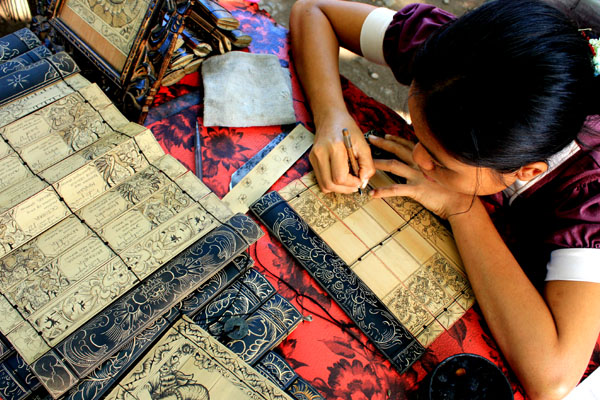Bali Culture - Bali Local Langguage

Balinese culture is compiled, documented and communicated through
Balinese language. When paper was not invented yet, its people
wrote their language on the palm leaf. In Balinese it’s
called lontar.
Languages in use were Old Javanese (Kawi) and Balinese. Each character
is carefully incised on the surface of palm leaf by sharp knife
or mutik. Having completed the writing, the entire works are then
rubbed with traditional ink made from lamp shot and oil to blacken.
Other than on palm-leaf, the also wrote on the surface of copper
plate or stone, especially for historical notes on temple or building
inscription. Both have become an important relic that retained
historical information for us today.
Writing Balinese language is not merely a matter of writing
activity. It comes into contact with the twin essences, namely
Balinese
language and its character. Preservation of the language seems
to have a good progress. Students starting from third year at
elementary school have been thought Balinese language and its
character. It is expected, they will have at least a basic knowledge
on this subject. Then, they are also proud of and remain to get
in touch with the root of their cultural identity. For student,
learning language just intended to get academic score and the
communication itself will be boring. But when trying other function
of language like expressing the beauty of languages though poetry,
prose or drama or the combination of language and picture (graphic)
like calligraphy and cartoon will be more immensely interesting
because this has put the language into its real practice where
emotion, time and space get involved together. The letter is now
widely developed as lovely souvenir
products sold to visitors.
Endeavour to preserve Balinese
language have also been undertaken though informal activities,
both the spoken and written. Spoken language have undertaken through
the chanting along with its paraphrasing into vernacular Balinese
language, poetry reading,
speech contest and interactive discourse through electronic media
(radio and television), while the written one is through the competition
of writing on lontar
leaf. The letter was frequently organized in several activities
such as in the Bali Art Festival, village youth club and some
other Balinese cultural events.
As a matter of fact, ancient lontar manuscript contain a variety
of knowledge, starting from literature, technical instruction
on farming, astrology, traditional herbal medicine, rituals, chronicle,
ethnic and so forth. By now, they are retaining in some museums
and >lontar documentation centres spreading though out Bali.
In relation to this preservation, Department of Balinese Studies
at Udayana University or elsewhere as the ‘think thank’
should be maintained at all times. Similarly, young generation
must be encourage to learn more about Balinese language along
with all aspect about it and keep on discovering the potency inside.














